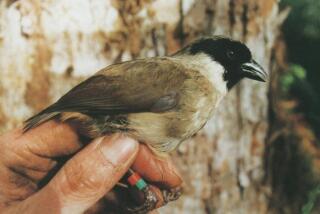Beauty Threatens Survival of Many Species : Wildlife: International trade in fur, animal parts is held responsible for 40% of the vertebrate species on the endangered species list.
- Share via
ASHLAND, Ore. — A Siberian tiger skin graces the floor of a Victorian hunter’s den.
Cobra heads mounted on the toes of snakeskin cowboy boots stare out from a curio shelf.
A bear’s gall bladder sits in the glass case of a Chinese apothecary.
These are all strands in the web of international trade in wildlife. That trade, in turn, is responsible for 40% of the vertebrate species on the endangered species list, said Ron Lamb, director of the Pacific Northwest Museum of Natural History.
Lamb has assembled an exhibit at the museum tracing the tusks, teeth, skins, bones, feathers, fur and even blood and internal organs of wildlife from poacher to the trophy rooms, gift shops and traditional Asian medicine shops where people buy them.
The exhibit, called “Beauty in the Beast,” runs through the winter.
“The problem with it is it’s absolutely gorgeous stuff,” said Lamb. “You look at it, and everybody says, ‘Oooooh, I’d love to have something like that.’ That’s what drives the trade.
“We’re the problem. Not the people who do the poaching. If we didn’t buy the stuff, they wouldn’t poach it.”
The exhibits were assembled from the warehouse of the U.S. Fish and Wildlife Service Forensics Laboratory, located next door. Python skins, elephant tusks, crocodile purses, a stuffed caiman sitting in an easy chair smoking a pipe--all were seized entering the United States illegally.
“It’s a big problem,” John Brooks, senior special agent for the U.S. Fish and Wildlife Service in Washington, said of the illegal trade in wildlife. “It rivals the drug trade as far as profit.”
The museum says international trade in wildlife goods amounts to as much as $5 billion to $8 billion a year--and as much as $3 billion of it is illegal. The biggest consumer in the world is the United States, which imports $1.2 billion a year in legal goods alone.
For illegal products, the markup is incredible. A horn from the muzzle of a black rhino might earn a poacher in Africa $50, but be worth $40,000 to a dealer, Brooks said. By the time it is ground up into dust and mixed with a potion for cure-all pills, the final markup could be $100,000.
“Ironically, the smaller horns are worth more, because they believe the potency is compacted,” Brooks said.
Human demand for wildlife products has a long history.
The belief that a person who eats something from an animal will acquire that animal’s strength and power has created a demand for wildlife products for traditional Asian medicine for 4,000 years. Chinese ivory carving dates from the Shang-yin period, which ran from 1783 BC to 1123 BC Trophy hunting was known in ancient Rome and blossomed at the turn of the 20th century, when it became fashionable for rich sportsmen to go on safari.
“As long as that tradition was practiced primarily by affluent individuals and there weren’t too many of them, there really wasn’t any stress on the populations of the animals,” Lamb said. “But at the present time, we continue that tradition, and there are so many more people. Then it puts a tremendous pressure on the wild population.”
A chart shows how rhino populations have gone from 250,000 in 1800 to 2,500 today. The numbers of tigers and elephants have made similar declines.
International laws and treaties have helped slow the killing.
The Convention on International Trade in Endangered Species, or CITES, was established in 1973 and has helped reduce poaching on elephants through a ban on international trade in ivory.
The U.S. Fish and Wildlife Service hopes educational programs will do more. Drawing on a huge reserve of confiscated wildlife goods, the agency is sending schools and museums special “Cargo for Conservation” boxes filled with sea turtle shells, cobra skin cowboy boots, coral boxes and the like.
“Young kids know more about what is going on than adults,” Brooks said. “I go into elementary schools and take confiscated artifacts. I’ll hold up a green sea turtle, and the kids will tell me, ‘That’s a green sea turtle. It lives in the ocean and it’s endangered.’
“If we can hold off until they get up to our age, maybe there is some hope.”
More to Read
Sign up for Essential California
The most important California stories and recommendations in your inbox every morning.
You may occasionally receive promotional content from the Los Angeles Times.













